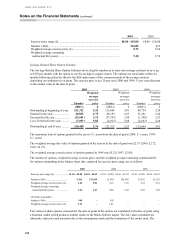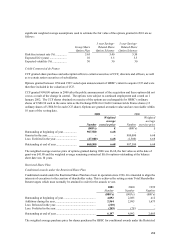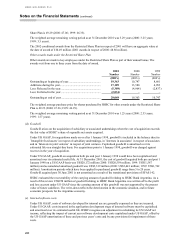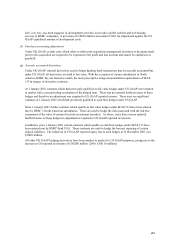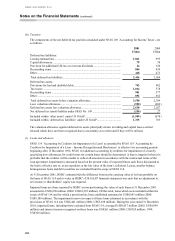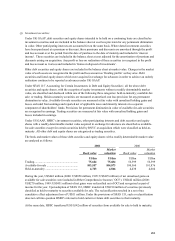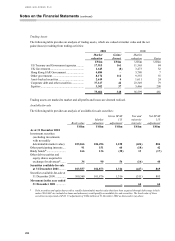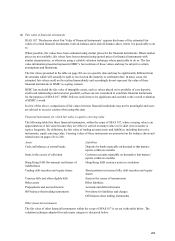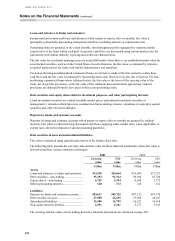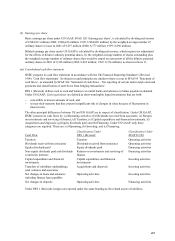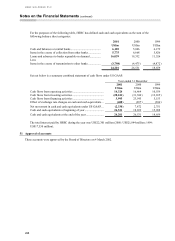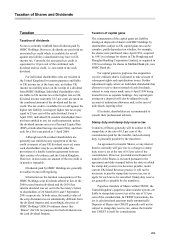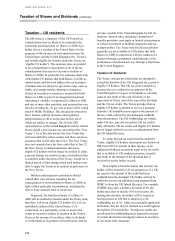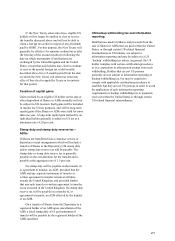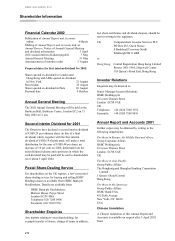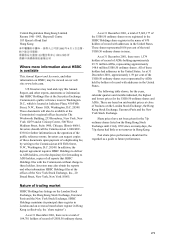HSBC 2001 Annual Report Download - page 265
Download and view the complete annual report
Please find page 265 of the 2001 HSBC annual report below. You can navigate through the pages in the report by either clicking on the pages listed below, or by using the keyword search tool below to find specific information within the annual report.
263
(j) Investment securities
Under UK GAAP, debt securities and equity shares intended to be held on a continuing basis are classified as
investment securities and are included in the balance sheet at cost less provision for any permanent diminution
in value. Other participating interests are accounted for on the same basis. Where dated investment securities
have been purchased at a premium or discount, these premiums and discounts are amortised through the profit
and loss account over the period from the date of purchase to the date of maturity and included in ‘interest
income’ . These securities are included in the balance sheet at cost adjusted for the amortisation of premium and
discounts arising on acquisition. Any profit or loss on realisation of these securities is recognised in the profit
and loss account as it arises and included in ‘Gains on disposal of investments’ .
Other debt securities and equity shares are included in the balance sheet at market value. Changes in the market
value of such assets are recognised in the profit and loss account as ‘Dealing profits’ as they arise. Debt
securities and listed equity shares which were acquired in exchange for advances in order to achieve an orderly
realisation continue to be reported as advances under UK GAAP.
Under SFAS 115 ‘Accounting for Certain Investments in Debt and Equity Securities’ , all the above debt
securities and equity shares, with the exception of equity investments without a readily determinable market
value, are classified and disclosed within one of the following three categories: held-to-maturity; available-for-
sale; or trading. Held-to-maturity securities are measured at amortised cost less provision for any permanent
diminution in value. Available-for-sale securities are measured at fair value with unrealised holding gains and
losses excluded from earnings and reported net of applicable taxes and minority interests in a separate
component of shareholders’ funds. Provisions for permanent diminution in value of available-for-sale securities
are recognised in earnings. Trading securities are measured at fair value with unrealised holding gains and
losses included in earnings.
Under US GAAP, HSBC’ s investment securities, other participating interests and debt securities and equity
shares with a readily determinable market value acquired in exchange for advances are classified as available-
for-sale securities except for certain securities held by RNYC at acquisition which were classified as held-to-
maturity. All other debt and equity shares are categorised as trading securities.
The book and market values of these debt securities and equity shares with a readily determinable market value
are analysed as follows:
2001 2000
Book value Marke
t
valuation Book value Market
valuation
US$m US$m US$m US$m
Trading............................................................ 75,684 75,684 56,599 56,599
Available-for-sale ........................................... 103,557 104,873 100,560 101,876
Held-to-maturity ............................................. 4,703 4,866 4,438 4,604
During the year, US$442 million (2000: US$850 million, 1999: US$425 million) of net unrealised gains on
available for sale securities were included in Other Comprehensive Income (‘OCI’ ). US$442 million (2000:
US$270 million, 1999: US$431 million) of net gains were reclassified out of OCI and recognised as part of
income for the year. Upon adoption of SFAS 133, HSBC transferred US$190 million of securities previously
classified as held to maturity to securities available for sale. The reclassification resulted in a net of tax
cumulative effect adjustment loss of US$11 million. Under the provisions of SFAS 133, such a reclassification
does not call into question HSBC’ s interest to hold current or future debt securities to their maturity.
At the same date, HSBC transferred US$1,042 million of securities from available for sale to held to maturity.







